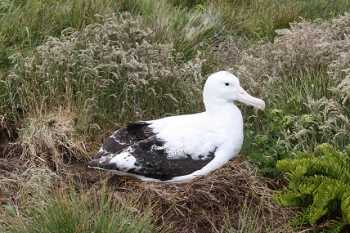Alex Bond (The Natural History Museum, Tring, UK) and colleagues have published open access in the Journal of Ornithology on the likely years of extinction of three breeding birds on Tristan da Cunha in the South Atlantic. The Critically Endangered Tristan Albatross Diomedea dabbenena is likely to have been locally extinct (as a breeding species) on the island by 1880, thought due mainly to over-exploitation by the island’s human population.
The paper does not consider the ACAP-listed Southern Giant Petrel Macronectes giganteus which has bred on Tristan da Cunha in the past, but no longer does so. A recent record of a vagrant Tristan Albatross photographed ashore on Tristan is also not mentioned.
The paper's abstract follows:
“The overwhelming majority of avian extinctions have occurred on islands, where introduced predators, habitat loss, disease, and human persecution have resulted in the loss of over 160 species in the last 500 years. Understanding the timing and causes of these historical extinctions can be beneficial to identifying and preventing contemporary biodiversity loss, as well as understanding the nature of island ecosystems. Tristan da Cunha (henceforth “Tristan”), the most remote inhabited island in the world, has lost three species from the main island since permanent human settlement in 1811—the Tristan Moorhen (Gallinula nesiotis), Inaccessible Finch (Nesospiza acunhae acunhae), and Tristan Albatross (Diomedea dabbenena). We used recently developed Bayesian methods, and sightings of mixed certainty compiled from historical documents, to estimate the extinction date of these three species from Tristan based on specimens. We estimate that all three species were likely extirpated from Tristan between 1869 and 1880 following a period of significant habitat alteration and human overexploitation, and only the albatross had a high probability of persistence when Black Rats (Rattus rattus) arrived in 1882, the previously assumed cause of extinction for all three species. Better estimates of extinction dates are essential for understanding the causes of historical biodiversity loss, and the combination of historical ecology with modern statistical methods has given us novel insights into the timing and therefore the causes of extinctions on one of the most isolated islands in the world.”

The Tristan Albatross no longer breeds on Tristan da Cunha, photograph from Gough Island by Kalinka Rexer-Huber
Reference:
Bond, A.L., Carlson, C.J. & Burgio, K.R. 2018. Local extinctions of insular avifauna on the most remote inhabited island in the world. Journal of Ornithology. doi.org/10.1007/s10336-018-1590-8.
John Cooper, ACAP Information Officer, 18 August 2018

 English
English  Français
Français  Español
Español